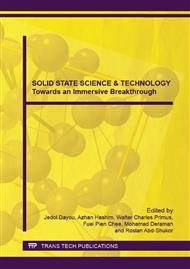p.491
p.496
p.502
p.508
p.514
p.520
p.526
p.530
p.536
Modelling and Simulation Approach for Organic Thin-Film Transistors Using MATLAB Simulation
Abstract:
As organic transistors are preparing to make improvements towards flexible and low cost electronics applications, the analytical models and simulation methods were demanded to predict the optimized performance and circuit design. In this paper, we investigated the analytical model of an organic transistor device and simulate the output and transfer characteristics of the device using MATLAB tools for different channel length (L) of the organic transistor. In the simulation, the Pool-Frenkel mobility model was used to represent the conductive channel of organic transistor. The different channel length has been simulated with the value of 50 μm, 10 μm and 5 μm. This research paper analyses the performance of organic thin film transistor (TFT) for top contact bottom gate device. From the simulation, drain current of organic transistor was increased as the channel length decreased. Other extraction value such sub-threshold and current on/off ratio is 0.41 V and 21.1 respectively. Thus, the simulation provides significant extraction of information about the behaviour of the organic thin film transistor.
Info:
Periodical:
Pages:
514-519
Citation:
Online since:
June 2015
Price:
Сopyright:
© 2015 Trans Tech Publications Ltd. All Rights Reserved
Share:
Citation:


